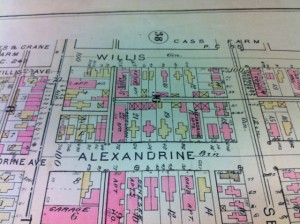
It was pouring rain. The kind of rain where you park your car in a certain location, perhaps only a block away. You are relatively dry when you step out of your car, but by the time you reach your destination, you look as if you have been deep sea diving in all of your clothes. That kind of rain.
We would not be deterred. Jason and I left the Green Garage together around 10 am on Tuesday, April 29, and headed downtown to the Coleman Young Municipal Building where we were scheduled to meet with Janese Chapman of Detroit’s Historic Designation Advisory Board. The hope was that we would find a treasure trove of slides and other documents that would help us begin piecing together not only the history of the El Moore itself, but the immediate neighborhood surrounding the building as well. Call us slaves to curiosity, but we just couldn’t quite settle for the idea of purchasing a beautiful Detroit historical building such as this without educating ourselves about, well, its history. A building like this has stories to tell, and we want to listen.
So our appointment with the Historical Designation Department had been on the calendar for awhile, and once we arrived, Ms. Chapman had all the relevant documents available and spread out on a broad wooden table for us to review. She also made sure to offer to search for anything else we needed if what we were searching for wasn’t there, before she retired to the rear of the office to continue her work.
At first glance it wasn’t certain we had what we needed. We were looking more for slides and there didn’t appear to be that many initially. But then we took a look at Volumes 1 and 2 of the North Cass Corridor Intensive Level Survey, and what we found there was pretty close to fascinating. What we found contained in those volumes were not only photographs of buildings in the area, some of them no longer there, but very detailed individual histories of those buildings including (in most cases) when they were built, who built them, who owned them, the cost of construction, what the building was used for, and even the names of building occupants.
For example, most of the homes surrounding the El Moore were built in the latter part of the 1800s, as was the El Moore. The building located at 619 West Willis, originally owned by a man named Richard Austin, was occupied by Austin and his family for nearly 50 years from 1885 to 1940 during what was a very transformational period for the Cass Corridor when the area was swiftly becoming more densely populated and went from being on the city’s edge to being more centrally located as the boundaries stretched ever outward. Large single-family homes began to make way for more apartment-style living.
By the way, interesting fact about Mario’s Italian Restaurant? It wasn’t a restaurant until the 1940s. Before then it was an auto parts facility and was active in the War effort during World War II.
I have officially designated the area surrounding the El Moore as Varneyville because of all the structures (including the El Moore) constructed by A.C. Varney in the area. More to come on that – and about A.C. Varney – in later posts, but suffice to say Mr. Varney definitely made his mark in the Cass Corridor. Another interesting related note? The building next door to the Green Garage, the building Model D Detroit calls home, was constructed by Varney. The Bronx Bar was originally constructed as an addition.
The El Moore? Built in 1898, it was originally called the El Moore flats. It was designed by Varney, one of the city’s most prominent architects, and constructed by Charles W. Moore at an estimated cost of $24,000. Initially the building contained eight rather huge apartments that were later converted to 17 apartments and eight sleeping rooms, and then finally into 25 apartments. This was a clear sign of how fast Detroit was growing, largely due to the auto industry.
Both Moore and Varney were very interesting men whom we plan to investigate more thoroughly in later posts, so stay tuned.
